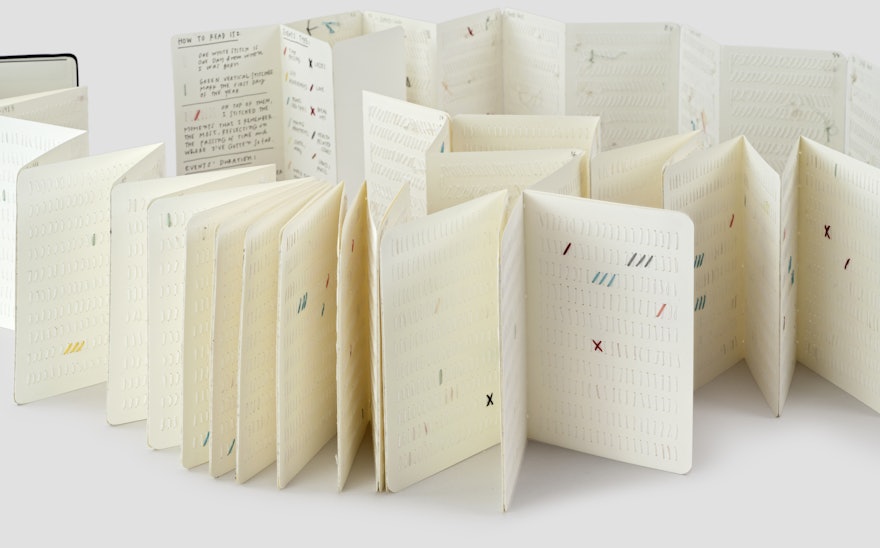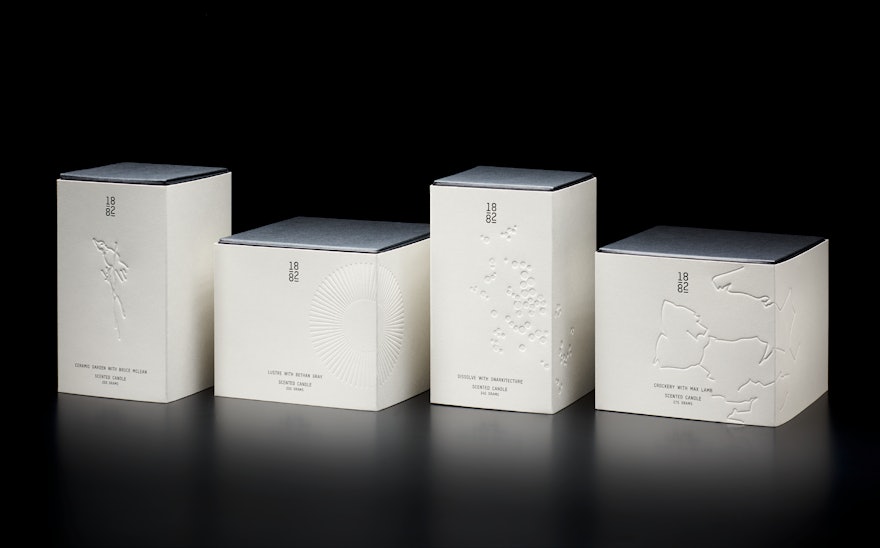Data can be used to describe the details of our daily lives, revealing the hidden patterns that make us who we are. Pentagram partner Giorgia Lupi explores her own data in Book of Life, a new artist book created for the Moleskine Foundation. Using iconic Moleskine notebooks, Giorgia tells her story through data represented by a series of colorful stitches, one for each day of her life so far.
Giorgia was invited by the Moleskine Foundation to create the book, which will become part of its collection. The Foundation is a non-profit organization that pursues a mission of “Creativity for Social Change.” It holds one of the largest collections of artists’ notebooks in the world, with more than 1,300 donated by artists, designers, writers and other makers that include William Kentridge, Patricia Urquiola, Sigur Ros, Mary Ellen Mark, Todd Oldham, Hans Ulrich Obrist and Pentagram partner Paula Scher, among many others. The collection is freely accessible via an online archive and is showcased at museums, art festivals, exhibitions and biennials all over the world. The Foundation operates independently from the Moleskine Company, whose financial contributions help sustain its programs.
The Foundation suggested the topic “What comes first?” to Giorgia, which is the 2022 theme for its educational program, AtWork. The initiative uses the notebooks to help inspire the creative process in young people. In a workshop conducted by the artist, students explore issues such as identity, culture and community through self-reflection, and as a final project, produce their own personalized notebook.
The question “What comes first?” personally resonated with Giorgia. At the time, she was about to turn 40 and decided to use the notebook to reflect on her life so far. As a designer and artist, she likes to start with questions and then investigate possible answers through her creative practice, while exposing the process at the same time. She has used Moleskine notebooks for over 20 years, and welcomed the opportunity to support the mission of the Foundation and to inspire young people.
In the notebook, Giorgia uses the simple activity of hand-stitching to create a complex and detailed account of her existence, marking all the life events, starting from her birth on July 24, 1981, that she recalls or had an impact on her. The concept echoes “Dear Data,” the project in which Giorgia and her friend Stefanie Posavec collected and shared personal data both to get to know each other and look at the larger trends in their lives. The approach utilizes the principles of “data humanism”––using data to uncover human stories behind the numbers and statistics.
“I wanted to capture the totality of my life in paper and thread––both key events that I felt were pivotal to the trajectory of my life, and the mundane of the day-to-day,” Giorgia says.
To begin, she disassembled three Moleskine notebooks, then re-assembled their pages in an accordion. She then stitched the pages with thread––14,496 stitches to be exact, one for each day of her life up until that point. The color of the thread is white, almost the exact same color as the paper itself, to make the stitches almost imperceptible. On top of these stitches, she then made second stitches using colored thread to individually mark important moments in her life, moments she either remembered or had previously noted in her own personal ongoing data collection: from her first word to her first love, from important life achievements to health scares, from losses in her family to break-ups.
The final result is a visual archive of her memories, a meditation on the individual threads that weave together to make up her identity––tangibly recorded in a handmade “book of life.” Giorgia provides a legend at the start of the notebook to help “read” the different types of life events and their duration.
“It has been a laborious reflective exercise,” Giorgia says. “Acknowledging the passing of time and the days I have lived by physically marking each one, and then weaving subjective memories on it as a way of asking myself who I am now, what has made me who I am and where have I gotten so far.
“Flipping through the book, I am struck by how every day is rendered the same, one stitch after another––when in actuality, I know that each day has its own identity. The book makes me question: Who am I now? What has made me, me? And what has led me to where I am?
“I am a data observer, a data collector, and a believer that counting something means it matters. To expend time and effort with your past is a particularly potent form of self-awareness. It’s an exercise to document existence, a record of time, the happenings and places that make our lives what they are.
“I see it as a conversational device, the beginning of a conversation, as I see all forms of data.”

